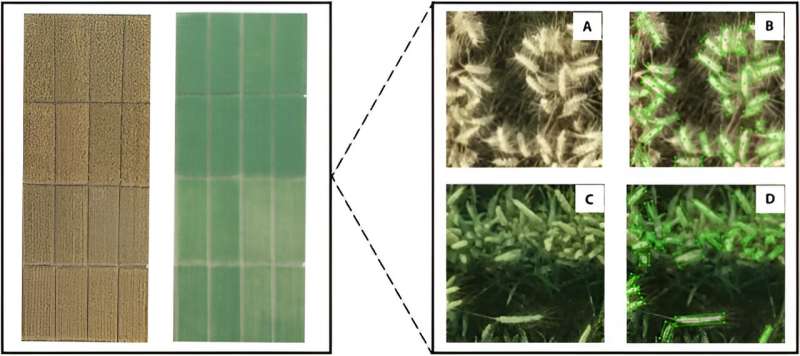This article has been reviewed according to Science X's editorial process and policies. Editors have highlighted the following attributes while ensuring the content's credibility:
fact-checked
proofread
WheatNet: Precision farming with advanced spike detection across maturity stages

In the quest for precision farming, accurately detecting wheat spikes through phenotyping is critical, with deep learning models emerging as a promising tool.
Despite advancements, these models face challenges in adapting to the dynamic nature of wheat growth, especially dealing with color variations at different stages, resulting in limited adaptability and accuracy. Current research concentrates on optimizing neural networks for better feature extraction and classification, utilizing strategies like stage-specific models and transfer learning.
However, challenges persist, including the need for extensive training data and the complexity of wheat spike characteristics. The pressing issue remains to develop a model that effectively integrates agronomic knowledge, addresses varying color features, and handles the dense distribution of wheat spikes, thereby enhancing detection accuracy across all growth stages.
Plant Phenomics published a research article titled "Small and Oriented Wheat Spike Detection at the Filling and Maturity Stages Based on WheatNet."
The study introduces WheatNet, a novel method for detecting small and oriented wheat spikes in UAV imagery from the filling to maturity stages. WheatNet integrates a Transform Network to minimize color feature discrepancies and a Detection Network to enhance detection capabilities.
Additionally, it introduces a Circle Smooth Label for classifying wheat spike angles and a micro-scale detection layer for small spike feature extraction. The method employs Complete Intersection over Union to minimize background interference.
To be specific, conducted on a high-powered workstation using PyTorch, the study utilized Stochastic Gradient Descent, batch processing, and specific optimization parameters. WheatNet demonstrated superior performance, achieving an average precision of 89.7% for spike detection and accurate description of morphology.
It maintained high precision even at a 0.95 recall rate, significantly outperforming other methods. The network achieved a detection speed of 20 FPS and showed excellent counting accuracy with low RMSEc, rRMSEc, and MAEc values. Ablation studies confirmed the effectiveness of the Transform Network, Circle Smooth Label, and micro-scale detection layer in addressing stage-specific detection challenges.
The study emphasizes that traditional field surveys are costly and inefficient and that image-based techniques, especially those capturing color and texture information, are increasingly valuable for accurate wheat spike detection across various growth stages.
In summary, WheatNet's capability to reduce detection errors due to color feature variations between stages, combined with its application across both filling and maturity stages, highlights its potential in field applications and accurate yield prediction. This end-to-end, single-stage model extends previous methods by adapting to multiple growth stages while maintaining high accuracy, offering a significant advancement over traditional and single-stage detection models.
More information: Jianqing Zhao et al, Small and Oriented Wheat Spike Detection at the Filling and Maturity Stages Based on WheatNet, Plant Phenomics (2023). DOI: 10.34133/plantphenomics.0109
Provided by Plant Phenomics





















